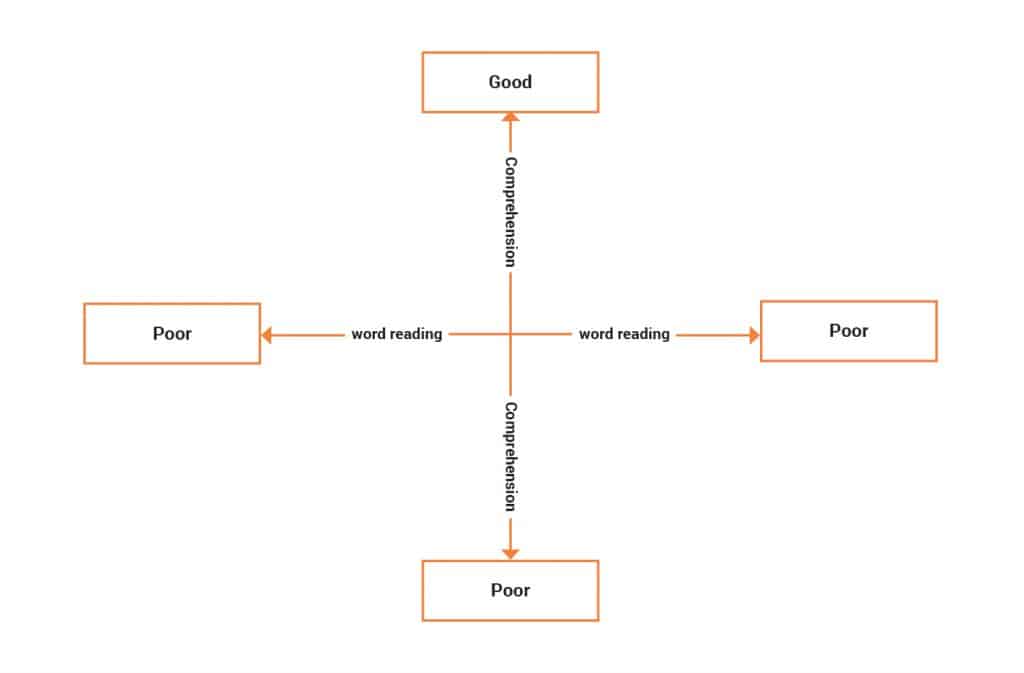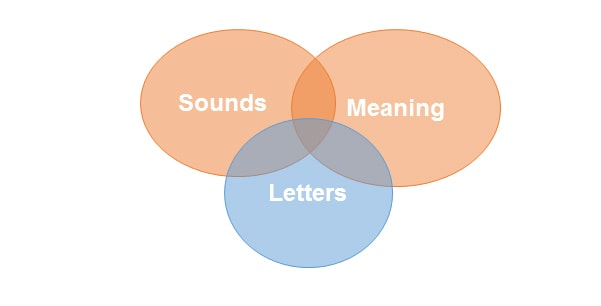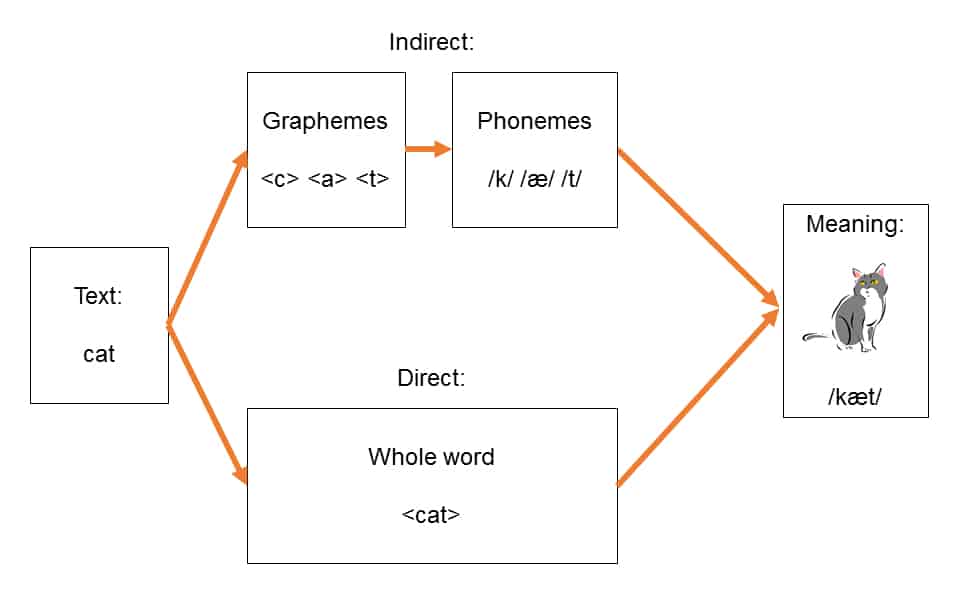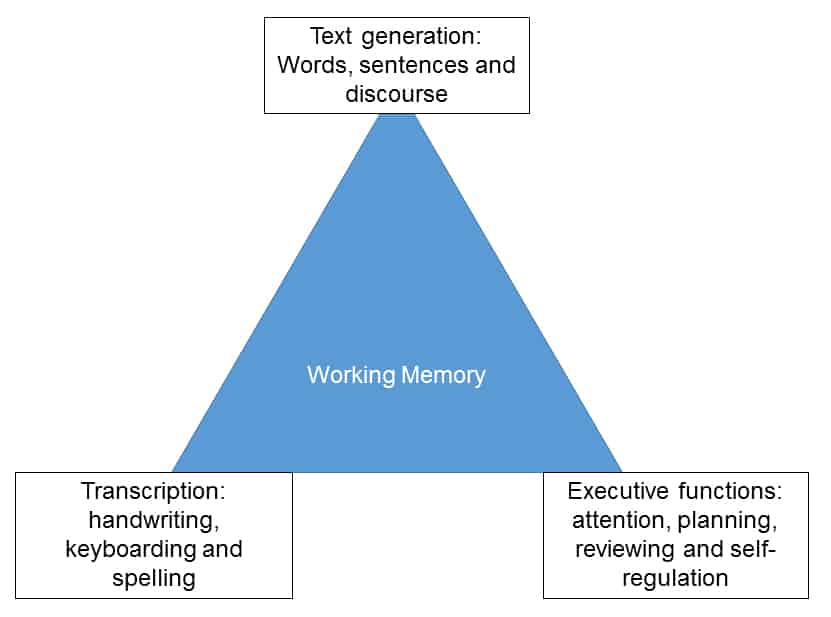Literacy is an essential life skill, not only for accessing education but for participation in society more broadly. Children who struggle to read and write will find it difficult to access all areas of the curriculum. Adults with low literacy not only have limited employment opportunities but also worse health outcomes. It is crucial that we support students to attain good literacy skills.
The purpose of literacy is to share meaning between an author and a reader – to understand what others have written, and to share your own ideas with others. However, the written form of English is not independent from the spoken form. It is an alternative set of visual symbols that were arbitrarily mapped onto the spoken language so that messages could be shared over space and time. Most children begin to learn to read and write following many years of experience understanding and speaking spoken English. Unlike spoken language, which usually develops spontaneously given sufficient exposure to speech, literacy normally depends upon explicit instruction. Here, we review research evidence about the early stages of literacy development so that we can explore which forms of literacy instruction are most effective.
Literacy depends upon a wide range of language and cognitive skills. Theories of skilled literacy are concerned with the processes that are used during reading and writing. Theories of literacy development describe how literacy changes as children gain the language and cognitive skills that underpin those processes. To maximise the benefits of literacy instruction, it is essential to understand the processes used during reading and writing, and the skills that need to be in place to enable those processes to function efficiently. Only then can we understand broader factors that influence the development of those skills, such as affective factors including self-efficacy and motivation, or environmental factors including the home and school literacy environment.
When describing literacy, it is useful to distinguish between reading and writing, and to also separate individual words from connected text, forming four areas of literacy (see Table 1: Areas of Literacy). At the level of individual words, literacy is comprised of word reading and spelling. At the level of connected text, literacy is reading comprehension and writing composition. These areas of literacy are interrelated but distinguishable. Distinguishing between areas of literacy in this way enables us to think more precisely about underlying skills, and to consider why particular weaknesses impact on certain areas of literacy more than others.
Table 1: Areas of literacy
| Word | Text | |
| Reading | Word reading | Reading comprehension |
| Writing | Spelling | Writing composition |
Very few models of literacy attempt to account for both word level and text level processes. A popular exception is the Simple View of Reading, which is depicted in Figure 1. This theory argues that reading is the product of decoding written words and language comprehension skills[1]. The Simple View of Reading defines decoding as recognition and understanding of visually presented words. In other words, this includes both letter-by-letter decoding skills and automatic word recognition. Here, we refer to this as Word Reading. Language comprehension is defined in the Simple View of Reading as the ability to take word level information and use it at sentence and discourse level. In other words, language comprehension encompasses all of the knowledge about language needed to understand the meaning of sentences and paragraphs that goes beyond recognising specific words.
The distinction between word reading and comprehension is supported by a great deal of research. In particular, children can have strengths in one dimension but weaknesses in another. Those who are good at both word reading and comprehension read well. Those with weaknesses in either or both dimensions will have difficulty reading but will show different profiles of reading difficulties. This has important implications for teachers, because it informs what teachers should do to help these children overcome their difficulties. A child who has word reading difficulties needs a targeted word reading intervention such as phonics. A child who can read words well but struggles with comprehension will not benefit from the same approach. To be useful for teachers in terms of appropriate next steps for individual students, reading assessments need to distinguish between these two dimensions.

Figure 1: Simple view of reading[2]
Reading and spelling individual words: Knowledge about sounds, letters and meaning
Much of early literacy development is concerned with learning to read and spell individual words. Knowledge about words is stored in the mental lexicon – our internal vocabulary or dictionary. The mental lexicon is accessed by both speech and literacy processes. When a child learns spoken language, they learn to link a set of sounds (the spoken form) with a specific meaning. When that child learns to read, they learn the written form of a word that links to the spoken form and the meaning. Early in learning to read, a child will largely be mapping letters to spoken words already in their mental lexicon, while later in development, they may be learning entirely new words through reading. Knowledge about words can be summarised in terms of two areas: knowledge about sounds, letters and meaning, and the connections between those areas of knowledge (see Figure 2).

Figure 2: Knowledge about words
It is not just the number of words in the mental lexicon that matters, but also what is known about those words. Each word has a representation, or set of information about it, stored in our heads. The amount of information held in that representation varies for different words. For example, there may be words such as ‘languid’ that we understand but do not really use, and other words such as ‘relaxed’ that we know and use in a variety of contexts. This is known as lexical quality[3], or the amount that is known about a word. This influences how easy it is to read or spell. A high-quality representation contains detailed information about the sounds and letters that form the word, as well as information about the meaning(s) of the word. All of this information overlaps. For example, knowing that ‘relaxed’ is a verb from the root ‘relax’ helps us to know that the /ks/ sound in the middle is spelt with an ‘x’ instead of a ‘ks’, and that the final sound is spelt ‘ed’. The word ‘languid’ on the other hand, has less information stored around it, and therefore it is harder to remember whether the /w/ sound in the middle of the word is spelt ‘w’ or ‘u’. The more information that is known about a word, the easier it is to use. Low quality representations are missing some of this detail, which makes it difficult to retrieve the correct pronunciation, spelling or meaning of the word. As children learn to read and write new words, they add additional information to their existing representations, and build new representations for words that are encountered for the first time.
There are different ways to read and spell words, and theoretical models of skilled reading and spelling often highlight these. Classically, researchers have talked about dual route models of reading, shown in Figure 3. In these models, when a reader encounters a written word, they might recognise it immediately and match it to a word meaning in their mental lexicon. This is known as the direct route. On the other hand, they might need to decode the word – that is, sound it out in order to link it to the meaning. This is known as the indirect route. The direct route, as the name implies, is generally quicker, but it is limited to words a reader has already learned to recognise. The indirect route takes longer but gives a reader a way to work out unknown words (although note that this model focuses only on reading single words, not words in context). There is good evidence that skilled, adult readers demonstrate these two different types of reading processes.

Figure 3: Dual route model of word reading[4]
Models of literacy acquisition need to account for how young children develop these reading skills. Theories often focus on the development of the alphabetic principle – understanding that there is a systematic correspondence between letters and sounds[5]. Once children grasp the alphabetic principle, they have a mechanism they can use to decode the written word into a spoken word, or vice versa. In other words, they have developed the indirect route in the dual route model above. Children often take months or even years to grasp the alphabetic principle fully. For example, researchers[6] describe an initial partial alphabetic stage, when children can use their knowledge to decode particularly salient parts of words, such as the first and last letters. Once they are able to decode all graphemes in a word, children enter the full alphabetic stage.
In English, knowing about the alphabetic principle is often not enough to get to the correct spelling of a word. Knowledge about word structure is also important. Words are made up of phonemes (the smallest unit of sound), graphemes (letter or letter combinations used to represent a phoneme) and morphemes (the smallest unit of meaning). Over recent decades, a great body of research has highlighted the importance of knowledge about morphemes for literacy. Morphemes, such as the noun ‘dog’ or the plural suffix ‘s’, are usually spelled consistently even when pronunciation varies. For example, the plural suffix is spelled the same in ‘dogs’, ‘cats’ and ‘horses’ even though the sounds differ. Knowledge about morphemes helps to disambiguate spelling when letter-sound rules are not sufficient. For example, you are more likely to spell the /s/ sound in ‘electricity’ correctly if you know the word is related to ‘electric’. Because morphemes represent meaning reliably, this knowledge can also help children to figure out the meaning of newly encountered words. For example, breaking down novel words into morphemes (for example, ‘un-google-able’) helps to understand them. Morphemes also provide grammatical information (for example, ‘ing’ and ‘ed’ endings signal a verb), so this knowledge is important not only for word level literacy but also for reading comprehension and writing composition of connected text. Recent developments in theory highlight the multiple ways in which knowledge of morphology influences reading and writing[7].
Traditionally it was argued that morphological information is integrated later in development, during the consolidated alphabetic[8] or orthographic stage[9]. According to these theories, understanding the links between letters and sounds must be fully developed before other sources of information about words can be used. If true, that would have important implications for education. This idea is discussed further in The pedagogy of reading.
The direct route in the dual route model corresponds more directly to what teachers often call ‘sight word reading’. However, it is not the case that the direct route involves only visual processes. We now know that even the direct route activates letter and sound knowledge as well as whole word knowledge. It is the accumulation of information from both direct and indirect routes which speeds up reading of familiar words. Further, there is a mechanism, known as the ‘self-teaching mechanism’[10], by which sounding out words through the indirect route can lead to direct word recognition over time. The theory behind this is that, each time a reader successfully sounds out a word using the indirect route, they add some information to that word representation, which means they are more likely to be able to use the direct route in the future. In this way, students can grow their reading vocabulary without direct instruction from a teacher.
In addition to learning from explicit teaching and their own sounding out attempts, children also show implicit, statistical learning about the words they read. Statistical learning refers to an implicit learning about the patterns in a language. As a result, children tend to follow the conventions of their writing system even if they have not been explicitly taught. For example, ‘ck’ is a spelling sometimes found at the ends of words (such as ‘rock’), but never at the start of words (for example, ‘kite’ and ‘cat’), and children are more likely to use ‘ck’ to represent a /k/ sound at the end of a word than at the start of a word[11]. This implies that it is important that children have plenty of exposure to written language in order to develop this statistical knowledge.
Reading and writing connected text
Of course, word recognition is only one small part of successful literacy. Reading comprehension and writing composition of connected text build upon word level literacy skills, but also depend upon additional skills such as understanding of language structure, background knowledge (topic knowledge and knowledge about narrative structure), and verbal inferencing skills.
Reading and writing are goal directed behaviours. The goal is for an author to share the meaning of a message with a reader. Interpreting that message involves more than just summing the meaning of individual words. Meaning is constructed across words, phrases and sentences. Readers build mental models as they read – they imagine what the text describes and continually update those mental models as they encounter new information. These mental models are essential for comprehension because, most of the time, text is not fully complete. Readers have to make inferences to fill in the gaps. Literal inferences are made using only the information in the text. For example, when reading the sentence ‘Libby is taller than Helen and Helen is taller than Ava’, the reader can also infer that Libby is taller than Ava. In other cases, the reader needs to make use of background knowledge on a topic to fill in the gaps. Because of this, it is easier to build a detailed and coherent mental model about familiar topics. For example, a child who has never been camping might have a hard time understanding a text about a camping trip – they may struggle to imagine the scene and the scenarios described in the text, and may also lack specific vocabulary related to camping.
If word level processes demand a lot of cognitive resources, this will restrict text level processes. For example, if a child reads each individual word by laborious letter-by-letter decoding to access meaning, they will struggle to build a coherent picture of meaning across the sentence, or to consider the narrative structure of a passage. However, as word reading skills improve and become more automatic, this frees up capacity for higher order comprehension skills.
Far less empirical research has explored the processes that underpin writing composition compared to any other area of literacy. The Simple View of Writing (sometimes called the ‘Not So Simple’ View of Writing to highlight how much more complex it is than reading) demonstrates that writing composition depends on three areas of skills that are all reliant on working memory: transcription, text generation, and executive functions[12]. This is illustrated in Figure 4 below. While reading and writing depend on many of the same skills and processes, this does not mean that writing is simply the reverse of reading. Spelling and writing composition place more demands on the cognitive system than word reading and reading comprehension. Writing composition in particular places greater demands on additional skills such as planning and goal maintenance even for adults.

Figure 4: The Simple View of Writing
Non-cognitive factors: The role of motivation and engagement
So far, we have focused on the cognitive components of reading and writing such as decoding, letter knowledge, and understanding of text, narrative and structure. However, reading and writing do not take place in a vacuum – students read and write for specific purposes, and have widely varying attitudes and beliefs around literacy. Broadly speaking, there are two types of non-cognitive factors that play a role in literacy development. The first is a child’s beliefs about themselves as a reader and writer – often referred to as their self-concept or self-efficacy. Children who believe that they are good at reading and writing are more likely to persevere with difficult tasks and more likely to engage positively with literacy. Positive self-efficacy comes from being shown how to do a task and experiencing success at a task[13]. This indicates that providing children with the tools needed for success (such as knowledge about language and the writing system) and setting achievable challenges are likely to lead to good progress.
The second area is motivation – the reasons why a child is doing a task. We know that intrinsic motivation – that is, doing a task because it is interesting or enjoyable, is closely associated with improvement, while extrinsic motivation – doing a task for rewards only – generally is not. This indicates that providing enjoyable, relevant tasks is also useful for progress. Literacy is an area of learning in which motivation is particularly important, because evidence shows that students who read for pleasure outside of school can substantially improve their vocabulary and reading skills, and thereby their life prospects[14]. Fostering positive attitudes towards reading and writing is vital.
The role of the home learning environment
All teachers know that the home environments of pre-school children vary widely. Researchers have suggested two dimensions on which the home literacy environment can differ[15]. First, parents provide differing levels of exposure to books and other literature. Some families enjoy shared reading of storybooks daily, while in other families this is much rarer. The second dimension is around the levels of direct, explicit instruction parents provide – for example, teaching a child to write their name or recognise road signs. The first dimension is related to broader language skills, while the second dimension relates to word-level decoding skills. In line with the Simple View of Reading, both kinds of input are needed to develop literacy successfully, but they can be provided in many different ways and in different environments (for example, at home and at school).
Interestingly, recent research cautions against assuming a direct causal relationship between the home literacy environment and children’s literacy outcomes. There is a large genetic component to reading ability, and parents and children share genes. Once they had accounted for this cause of similarities, researchers found no extra role for home literacy environment in children’s literacy levels[16].
In this research review, we have explained how literacy can be considered in terms of reading and writing at the word level and the text level. We have introduced the Simple View of Reading, which emphasises the separable roles for decoding and language, and touched on the (not so) Simple View of Writing, which highlights the role for executive function skills in composition. We have introduced the role of non-cognitive factors such as motivation and home literacy environment. In The pedagogy of reading, we address how these different factors underpin high quality literacy tuition.
Glossary
Alphabetic principle: the understanding that letters systematically represent phonemes within words.
Connected text: sentences and passages of text (contrasts with single word reading/spelling).
Decoding: using letter-sound rules to read a word.
Grapheme: a letter or combination of letters corresponding to a phoneme. For example both ‘c’ and ‘ch’ are graphemes that can correspond to single phonemes.
Mental lexicon: mental word store, vocabulary.
Morpheme: the smallest meaningful part of a word. For example, ‘cats’ is made up of two morphemes, the noun [cat], and the plural suffix [s].
Phoneme: the smallest unit of sound which changes the meaning of a word. For example, cat is made up of 3 phonemes /k/ /a/ /t/.
Phonics: the links between letters and sounds.
Representation: an event or pattern in the mind that represents (symbolises) something in the external world.
Word reading: reading a word on its own, without a sentence context.
Endnotes
[1] Hoover, W.A., & Gough, P.B. (1990). The simple view of reading. Reading and Writing, 2, 127-160.
[2] Adapted from Gough, P.B., & Tunmer, W.E. (1986). Decoding, reading, and reading disability. Remedial and Special Education, 7(1), 6-10.
[3] Perfetti, C. (2007). Reading ability: Lexical quality to comprehension. Scientific Studies of Reading, 11(4), 357-383.
[4] Coltheart, M. (2006). Dual route and connectionist models of reading: An overview. London Review of Education, 4(1), 5-17.
[5] Frith, U.(1985). Beneath the surface of developmental dyslexia, in K. Patterson, M. Coltheart, & J. Marshall (Eds), Surface dyslexia: neuropsychological and cognitive studies of phonological reading. London: LEA, pp. 301-330.
[6] Ehri, L.C. (2005). Development of sight word reading: Phases and findings, in Snowling, M., & C. Hulme (Eds.0, The Science of Reading: A Handbook. Malden, MA: Blackwell, pp. 135-154.
[7] Levesque, K.C., Breadmore, H.L., & Deacon, S.H. (2021). How morphology impacts reading and spelling: Advancing the role of morphology in models of literacy development. Journal of Research in Reading,44(1), 10-26.
[8] Ehri, L.C., (2005). Learning to read words: Theories, findings and issues. Scientific Studies of Reading, 9, 167-188.
[9] Frith, U.(1985). Beneath the surface of developmental dyslexia, in K. Patterson, M. Coltheart, & J. Marshall (Eds), Surface dyslexia: neuropsychological and cognitive studies of phonological reading. London: LEA, pp. 301-330.
[10] Share, D.L. (1995). Phonological recoding and self-teaching: Sine qua non of reading acquisition. Cognition, 55(2), 151-218.
[11] Treiman, R. (2018). Statistical learning and spelling. Language, Speech, and Hearing Services in Schools, 49(3S), 644-652.
[12] Berninger, V.W., et al. (2002). Teaching spelling and composition alone and together: Implications for the simple view of writing. Journal of Educational Psychology, 94(2), 291-304.
[13] Bandura, A. (1977). Self-efficacy: Toward a unifying theory of behavioural change. Psychological Review, 84(2), 191-215.
[14] Sullivan, A., & Brown, M. (2015). Reading for pleasure and progress in vocabulary and mathematics. British Education Research Journal, 41, 971-991.
[15] Sénéchal, M., & LeFevre, J.A. (2002). Parental involvement in the development of children’s reading skill: A five‐year longitudinal study. Child Development, 73(2), 445-460.
[16] van Bergen, E., et al. (2017). Why are home literacy environment and children’s reading skills associated? What parental skills reveal. Reading Research Quarterly, 52, 147-160.
By Professor Julia Carroll & Dr Helen Breadmore


